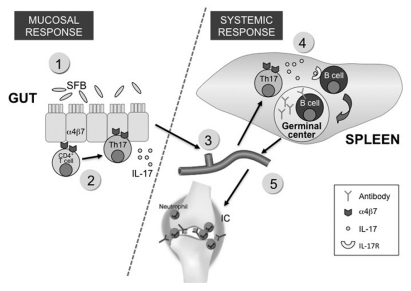Figure 2. An autoimmune arthritis model that demonstrates the link between gut microbiota and an extraintestinal disease. The K/BxN arthritis model was used to demonstrate how the gut microbiota can influence a non-gut-associated disease. K/BxN mice express a transgene-encoded T-cell receptor that reacts to a self-peptide. Colonization of SFB on the gut induces the differentiation of Th17 cells (step 1 and 2), which subsequently exit the gut and migrate into the peripheral lymphoid tissue. The gut-origin of Th17 cells can be identified by their expression of the α4β7 receptor, imprinted on these T cells by intestinal-mucosa-associated DCs (step 3). IL-17, in turn, acts directly on B cells to provide help in the differentiation of germinal center B cells and the production of autoantibody in spleen (step 4). The autoantibody then circulates into its target organ joints, which ultimately leads to the development of disease.

An official website of the United States government
Here's how you know
Official websites use .gov
A
.gov website belongs to an official
government organization in the United States.
Secure .gov websites use HTTPS
A lock (
) or https:// means you've safely
connected to the .gov website. Share sensitive
information only on official, secure websites.
